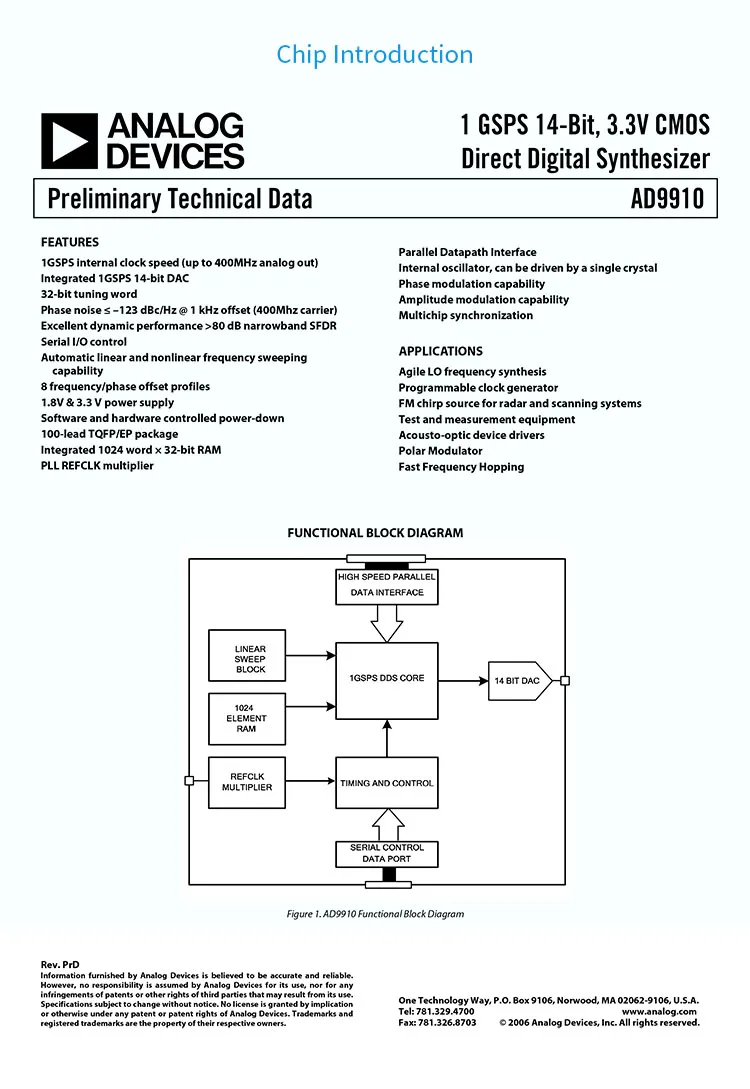Highlights:
The Module is a high-speed HDD5 module with built-in 14 bit DACE, supporting up to 1 G5PS sampling rate output up to 420M. Tantalum capacitor filter is used on the board to achieve the best filtering effect. AMS1117 is used as the power chip to make the power supply more stable.
Module parameters:
Module model: AD9910
Module type: digital synthesis frequency source
Module power supply: DC-5V
Module current: 400mA (MAX); quiescent current 70mA (TYP) normal drive current 390mA (TYP)
Module communication protocol: SPI serial
Module provides routines: STM32F103RCT6
Routine platform: STM32F103X-M3 KEIL5 version source code
Module system main frequency: 1000MHz (MAX)
DAC resolution digits: 14 digits
Phase accumulator bits: 32 bits
Module output interface: SMA; 24-hour salt spray anti-oxidation
Module output signal: sine wave; sine wave with 420MHz low-pass filter.
Module output channels: 2 channels; phase difference is 180 degrees, high-frequency output will have phase shift due to filter
The signal characteristics of the module: the sine wave has no coupling output; the output has its own DC component. If it is connected to the radio frequency equipment, please add a DC block, or you can directly use an oscilloscope to measure
Highest main frequency output sine wave signal range: 1Hz-420MHz
Output amplitude: sine wave 760mVpp (MAX); sine wave amplitude decreases with increasing frequency
Output impedance: 50 ohms
Module features: multiple; high-performance DDS sine wave signal generator, high-order elliptic filter, low-noise voltage regulator chip, etc.
Module application: multiple; frequency signal generation, sine wave signal generation, sensor excitation
Module interface type: SMA signal output and external clock input, DC5.5 power socket, XH2.54-26PIN double-row pin data interface
Module description:
The AD9910 is a direct digital frequency synthesizer (DDS) with a built-in 14 bit DAC that supports sampling rates up to 1 GSPS. AD9910 uses advanced DDS patented technology, which can greatly reduce power consumption without sacrificing performance. The DDS/DAC combination forms a digitally programmable high-frequency analog output frequency synthesizer that can generate frequency-agile sinusoidal waveforms at frequencies up to 400 MHz.
Users can access the same three signal control parameters used to control DDS, including: frequency, phase and amplitude. The AD9910 uses a 32-bit accumulator to provide fast frequency hopping and frequency tuning resolution. At 1 GSPS sampling rate, the tuning resolution is 0.23 Hz. This DDS also implements fast phase and amplitude switching.

Precautions for using the module
(1) The current consumption of the module is large, and the power supply needs to have a certain margin. It is recommended to use 5V1A or more for power supply.
(2) Since the module is a high-precision device, in order to avoid unnecessary interference, it is recommended to use a linear power supply.

Frequently asked questions:
Q: Can the main frequency and output amplitude of the module be adjusted?
